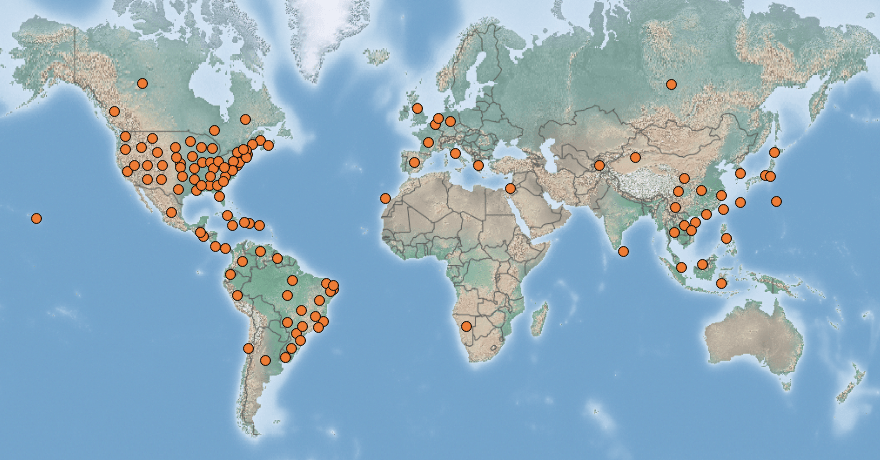Syn.: Rana catesbeiana Shaw, 1802
 |
American bullfrog | Status LU: absent. |
 |
Nordamerikaneschen Ochsefräsch | Status Eur.: established. IAS of EU concern (2016). |
 |
Ouaouaron, grenouille-taureau | RA: ISEIA: A0, Alert List. Harmonia+: n/a. |
 |
Nordamerikanischer Ochsenfrosch | Wikipedia: |
 |
Amerikaanse brulkikker | Back to the list of vertebrates |
Contents
Report the species
→ Report Lithobates catesbeianus to the National Museum of Natural History.
Brief description
Lithobates catesbeianus Shaw, 1802 inhabits slow-running waters, permanent ponds and ditches with dense vegetation. In Belgium, it is often found in fish ponds. The introduction of the bullfrog outside its native range poses a threat to amphibian populations around the world. The frog negatively affects native amphibians through competition and predation (namely green frog populations). It also preys on many other species, including arthropods, molluscs, fish and birds (eggs and young). Its tadpoles contribute to the species’ negative impact on native biodiversity. Moreover, the bullfrog is frequently reported to be a healthy carrier of the fungus Batrachochytrium dendrobatidis, an emergent infectious disease that is highly virulent, has low host-specificity and has been implicated in numerous species extinctions and global amphibian declines. The species is included in the appendix under recommendation no.77 of the Council of Europe as a species which has proven to be a threat to biological diversity and for which eradication is strongly recommended (Branquart et al. 2013).
IAS of Union concern
In 2016, Lithobates catesbeianus Shaw, 1802 was added to the list of invasive alien species of Union concern (Anonymous 2016) which implies that member states shall take all necessary steps to prevent it’s unintentional introduction or spread.
Status and distribution in Luxembourg
To date, there is no documentation of the species in Luxembourg (MNHNL, iNaturalist & GBIF, 2020).
Risk assessment
ISEIA protocol
A0 (3+3+3+3) = Alert List (Ries et al. 2014: 199).
Harmonia+ protocol
Not assessed yet.
Worldwide distribution
Bibliography
- Anonymous, 2016. Commission implementing regulation (EU) 2016/1141 of 13 July 2016 adopting a list of invasive alien species of Union concern pursuant to Regulation (EU) No 1143/2014 of the European Parliament and of the Council. Official Journal of the European Union L 189: 4-5.
- Branquart E., A. Laudelout, G. Louette, Y. Martin & C. Percsy, 2013. Harmonia database: Rana catesbeiana. Harmonia version 1.2, Belgian Forum on Invasive Species. URL: http://ias.biodiversity.be [accessed on 2019-10-25]
- CABI, 2019. Lithobates catesbeianus Shaw, 1802. In: Invasive Species Compendium. Wallingford, UK: CAB International. URL: www.cabi.org/isc [accessed 2020-04-21]
- MNHNL, iNaturalist & GBIF, 2020. Lithobates catesbeianus Shaw, 1802 in MNHNL-mdata, online portal combining species observation from Recorder-Lux, iNaturalist and GBIF. National Museum of Natural History, Luxembourg. URL: https://mdata.mnhn.lu [Accessed 2020-04-21]
- Ries, C., M. Pfeiffenschneider, Engel, E., J.-C. Heidt & M. Lauff, 2014. Environmental impact assessment and black, watch and alert list classification after the ISEIA Protocol of vertebrates in Luxembourg. Bull. Soc. Nat. luxemb. 115: 195-201. [PDF 247 KB]
Suggested citation of this webpage
Ries, C. & M. Pfeiffenschneider (Eds.), 2025. Lithobates catesbeianus Shaw, 1802. In: neobiota.lu - Invasive Alien Species in Luxembourg. National Museum of Natural History, Luxembourg. URL: https://neobiota.lu/lithobates-catesbeianus/ [Accessed 2025-12-31].
Page content last updated on 2020-04-21. Last proofread by Caroline Grounds on 2019-11-29.


